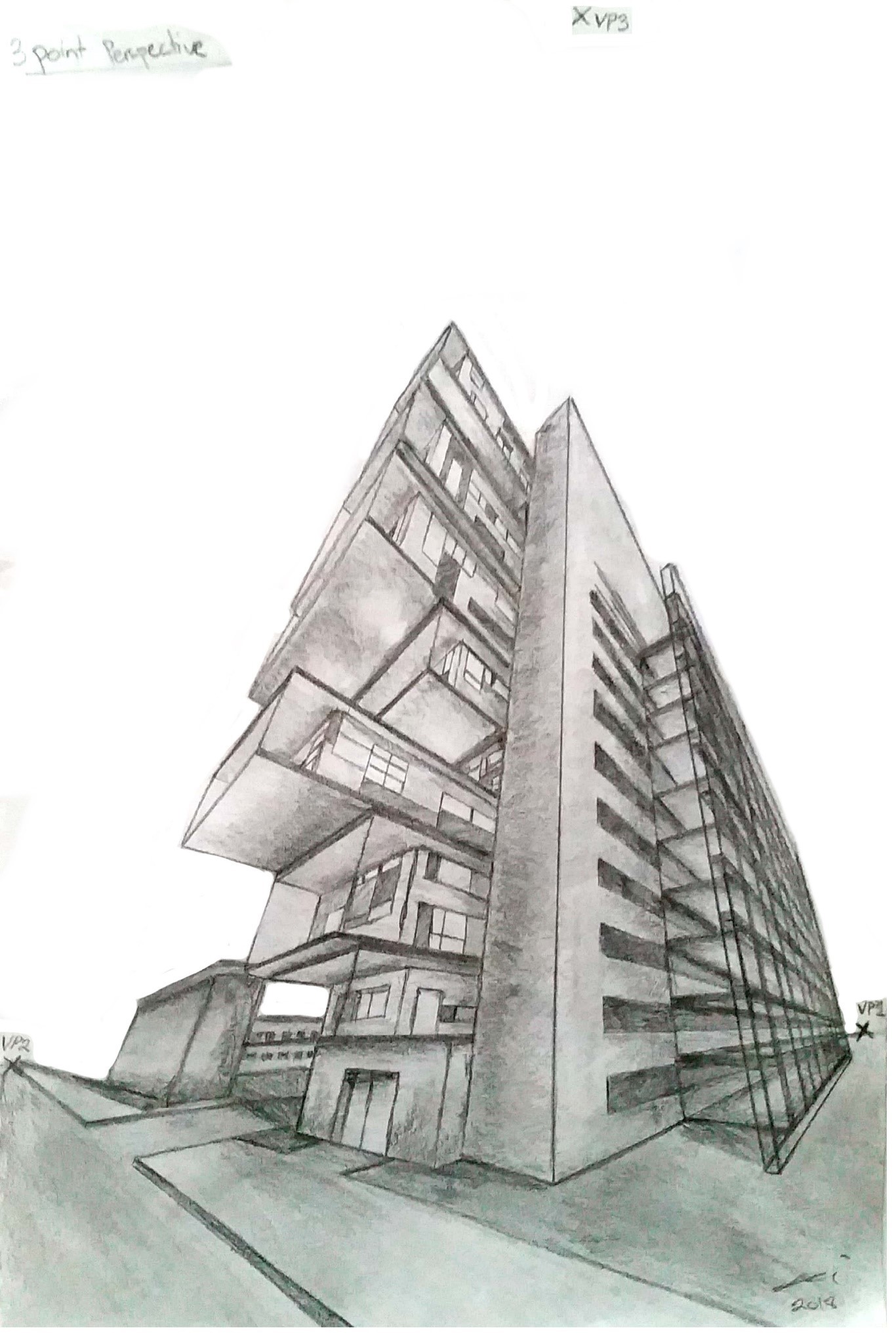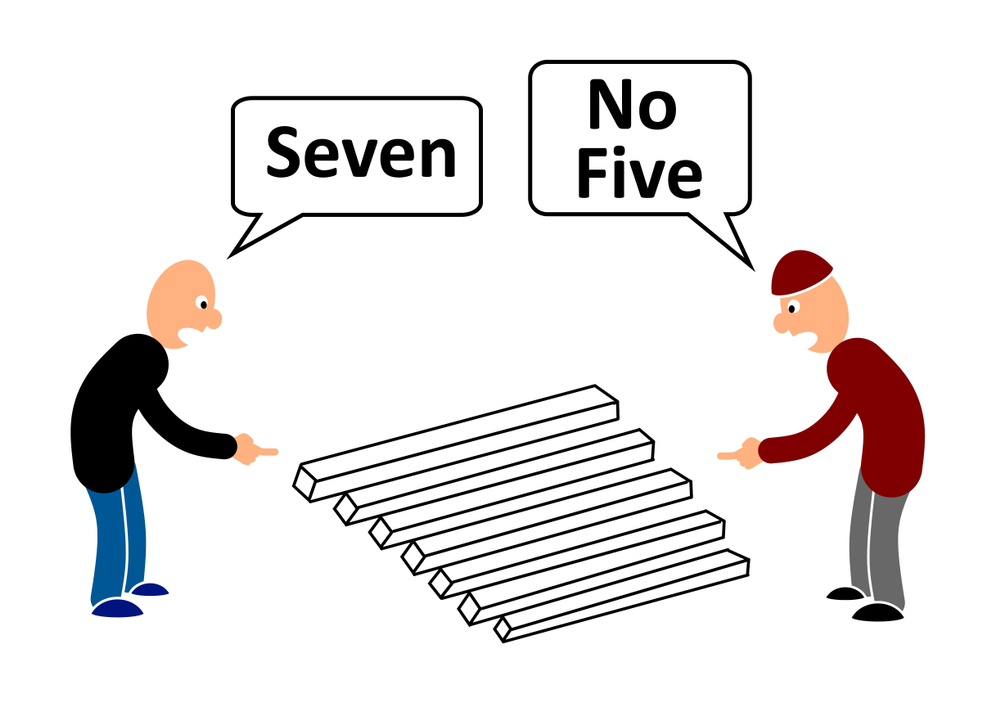Three Point Perspective Drawing Made Simple
Third-person limited point of view is when the narrator tells the story with the thoughts, feelings, and experiences of a single character from their point of view using the pronouns "she," "he," or "they.". The narrator will know everything that's happening from the main character's perspective, but can't see into the minds.

3rd Point Perspective Drawing Skill
Drawing with three-point perspective. Start by marking your horizon line and placing your three vanishing points—two along the horizon and one either above or below it, depending on your viewpoint. The third point radically changes the view, creating a sensation of height or depth. Next, draw a line from the third vanishing point to define.

67 3 POINT PERSPECTIVE DRAWING TUTORIAL PDF PerspectiveDrawing
First-person point of view. When we talk about ourselves, our opinions, and the things that happen to us, we generally speak in the first person. The biggest clue that a sentence is written in the first person is the use of first-person pronouns. In the first sentence of this paragraph, the pronouns appear in bold text. We, us, our, and ourselves are all first-person pronouns.

could be useful The Helpful Art Teacher THREE POINT PERSPECTIVE... WORM'S EYE vs. BIRD'S EYE
The biggest difference in three-point perspective is that there are three vanishing points (VPs). Two are along the horizon, just like two-point, but the third VP is located either above the horizon (at the zenith) or below the horizon (the nadir), depending on the area you intend to draw.. Remember that in basic one-point perspective, lines are either vertical, horizontal or recede toward the.

How to Draw 3Point Perspective for Beginners Narrated
Here are a couple of notable examples: Ernest Hemingway's "Hills Like White Elephants": This short story is a prime example of third person objective, as the narrator only reports the dialogue between the two characters and their actions, leaving their thoughts and feelings up to the reader's interpretation. Anton Chekhov's "The Lady with the.
.png)
Drawing in threepoint perspective
Point of view determines the extent of the details, or how the details are relayed to the reader. Think of it like the lens of a camera. First person point of view is the most restrictive, a close up, tightly focused, typically from one person's thoughts. In contrast, a third person narrator point of view is the most inclusive, a wide angle.

How to Draw Using ThreePoint Perspective Buildings Drawing Step by Step YouTube
Point of view (POV) is the narrative perspective from which a story is told. It's the angle from which readers experience the plot, observe the characters' behavior, and learn about their world. In fiction, there are four types of point of view: first person, second person, third person limited, and third person omniscient.

A StepbyStep Tutorial on the Basics of ThreePoint Perspective Craftsy
Third-person limited: A narrator reports the facts and interprets events from the perspective of a single character. For an example, see Katherine Mansfield's short story "Miss Brill." In addition, a writer may rely on a "multiple" or "variable" third-person point of view , in which the perspective shifts from that of one character to another.

THE ART OF THIRD PERSON PERSPECTIVE Yosef Farhi
The third-person perspective can vary in its focus, and a writer can adjust its proximity or bias. It's widely used in fiction but is also suitable for non-fiction. Third person compared to other points of view. Third-person point of view is distinct from other narrative styles due to its unique pronoun use.
Chris' Painting/Drawing Blog More on Perspective Drawing 3Point Perspective
In literature, third-person point of view follows multiple characters and narrative arcs, zooming in and out of a story the way a camera does in a movie. A third-person narrator can be all-knowing (aware of every character's thoughts and feelings) or limited (focused on a single character, or aware only what certain characters say and do).

3 point perspective exercise 2 by WillMangin on DeviantArt Perspective 3 Points, Perspective
Selecting the right point of view makes all the difference when crafting your story. Learn about each of the points of view, and what they each achieve.

How to Draw 3Point Perspective Skyscraper Building YouTube
The third-person point of view gives you the perspective of the person being talked about in a written work. When a story or novel has a third-person perspective, for example, a narrator describes what's happening with the characters and what they're doing. While you don't see the story from the character's point of view as you would with a.

3 point perspective drawing r/drawing
Third Person Point of View. In third-person narration, the narrator exists outside the events of the story, and relates the actions of the characters by referring to their names or by the third-person pronouns he, she, or they. Third-person narration can be further classified into several types: omniscient, limited, and objective.

Draw city buildings in 3 point perspective and looking down from above. 3 point perspective
By mastering the third person perspective, you can take your writing to new heights. Understanding the Third Person Point of View. In stories, point of view refers to the perspective from which the narrative is presented, and in Story Grid it is part of the NARRATIVE PATH. The third person point of view is a narrative mode where the author.
.png)
Drawing in threepoint perspective
The third person's point of view in movies refers to the perspective from which the action of a film is shown. It can be pretty tricky in movies, and it is helpful to understand how a shot is done. The point of view is through the camera and is known as "camera eye.". In simple words, it's the perspective seen through the eyes of the.

A StepbyStep Tutorial on the Basics of ThreePoint Perspective Craftsy
The third-person point of view is a common form of storytelling—a staple in works of fiction—in which the narrator uses third-person pronouns such as they, he, and she to best relate the action in the story. Most new writers shun writing in the third-person perspective but, unknown to them, it affords a writer much more freedom in how they.